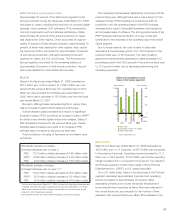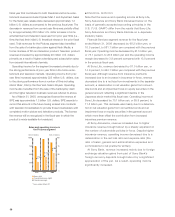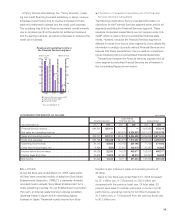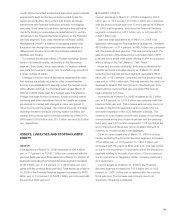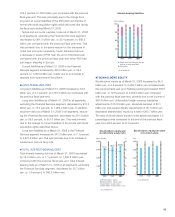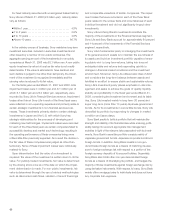Sony 2008 Annual Report Download - page 62
Download and view the complete annual report
Please find page 62 of the 2008 Sony annual report below. You can navigate through the pages in the report by either clicking on the pages listed below, or by using the keyword search tool below to find specific information within the annual report.
60
The increase in sales is mainly due to the contribution of sales
from Famous Music LLC (“Famous Music”), a U.S.-based
music publishing company that was acquired by Sony’s U.S.-
based music publishing subsidiary Sony/ATV Music Publishing
LLC (“Sony/ATV”) and consolidated in the current fiscal year,
the receipt of a settlement payment related to copyright
infringement claims and an increase in sales at SMEJ and
So-net. An increase in trademark royalty income from Sony
Ericsson also contributed to the increase in sales.
Sales at SMEJ increased compared with the previous fiscal
year mainly due to an increase in music download sales. Best
selling albums that contributed to sales during the fiscal year
included ORANGE RANGE’s ORANGE and RANGE, Ken Hirai’s
FAKIN’ POP and YUI’s CAN’T BUY MY LOVE.
Sales at So-net increased compared to previous fiscal year
primarily due to higher fee revenue from broadband connections,
especially fiber-optic.
Operating income for All Other increased compared to the
previous fiscal year, primarily due to recording a 10.0 billion
yen gain on the sale of “The Sony Center am Potsdamer
Platz” in Berlin, the receipt of a settlement payment related to
copyright infringement claims, an increase in trademark royalty
income from Sony Ericsson and an increase in operating
income at So-net.
Operating income at SMEJ increased approximately 4
percent, compared with the previous fiscal year, mainly due
to an increase in animation DVD sales as well as the above-
mentioned increase in music download sales.
Part of the gain on the sale of a portion of Sony’s former
headquarters site in the amount of 2.6 billion yen was included
in operating income within All Other in the previous fiscal year.
FOREIGN EXCHANGE FLUCTUATIONS AND RISK
HEDGING
During the fiscal year ended March 31, 2008, the average value
of the yen was 113.3 yen against the U.S. dollar, and 160.0 yen
against the euro, which was 2.4 percent higher against the U.S.
dollar and 7.1 percent lower against the euro, respectively,
compared with the average of the previous fiscal year.
In the Pictures segment, Sony translates into yen the U.S.
dollar consolidated results of SPE (a U.S.-based operation that
has worldwide subsidiaries). Therefore, analysis and discussion
of certain portions of the operating results of SPE are specified
as being on “a U.S. dollar basis.” Results on a U.S. dollar basis
are not on the same basis as Sony’s consolidated financial
statements and do not conform with U.S. GAAP. Sony does
not believe that these measures are a substitute for U.S. GAAP
measures. However, Sony believes that results presented on a
local currency basis provide additional useful information to
investors regarding operating performance.
Sony’s consolidated results are subject to foreign currency
rate fluctuations largely because the countries where manufac-
turing takes place may be different from those where such
products are sold. In order to reduce the risk caused by such
fluctuations, Sony employs derivatives, including foreign
exchange forward contracts and foreign currency option
contracts, in accordance with a consistent risk management
strategy. Such derivatives are used primarily to mitigate the
effect of foreign currency exchange rate fluctuations on cash
flows generated by anticipated intercompany transactions and
intercompany accounts receivable and payable denominated in
foreign currencies.
Sony Global Treasury Services Plc (“SGTS”) in London
provides integrated treasury services for Sony Corporation and
its subsidiaries. Sony’s policy is that Sony Corporation and all
subsidiaries with foreign exchange exposures should enter into
commitments with SGTS for hedging their exposures. Sony
Corporation and most of its subsidiaries utilize SGTS for this
purpose. The concentration of foreign exchange exposures at
SGTS means that, in effect, SGTS hedges most of the net
foreign exchange exposure of Sony Corporation and its subsid-
iaries. SGTS in turn enters into foreign exchange transactions
with creditworthy third-party financial institutions. Most of the
transactions are entered into against projected exposures before
the actual export and import transactions take place. In general,
SGTS hedges the projected exposures on average three months
before the actual transactions take place. However, in certain
cases SGTS partially hedges the projected exposures one
Sales and operating income
in All Other
2006 2007 2008
600
450
300
150
0
60
45
30
15
0
4.8%
8.1%
13.1%
(Yen in billions) (Yen in billions)
■¥Sales (left)
■¥Operating income (right)
●¥Operating margin
* Years ended March 31









